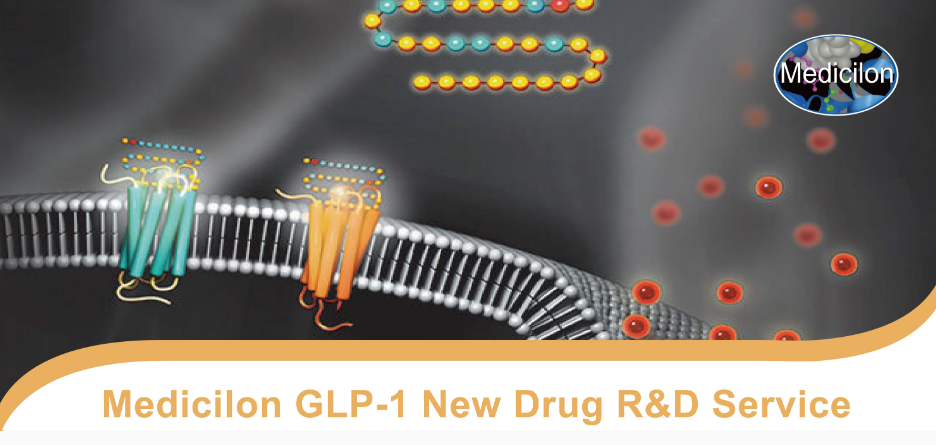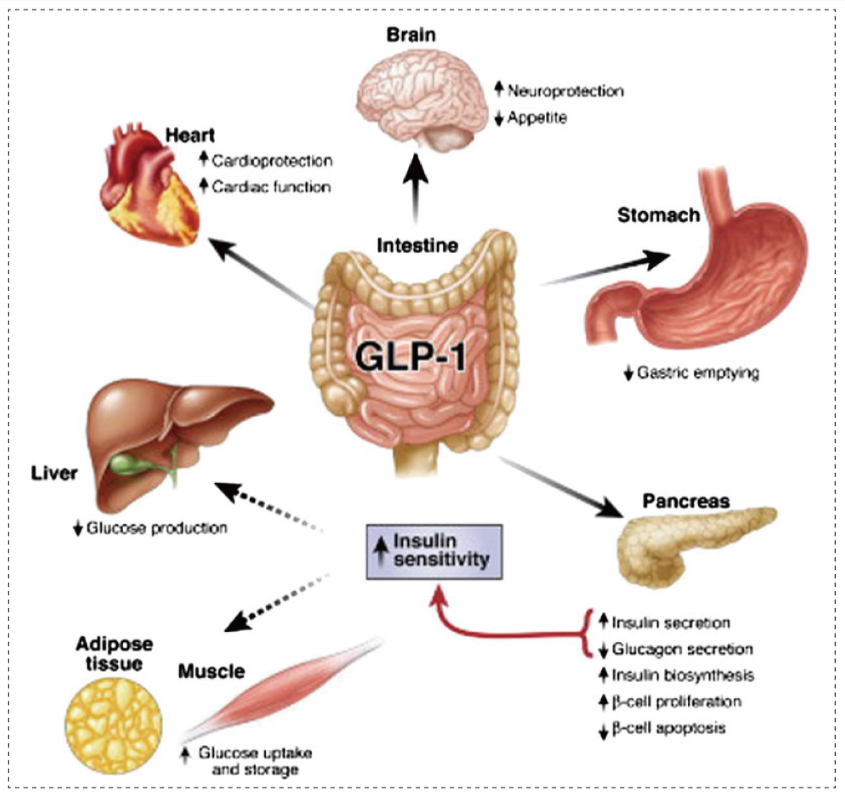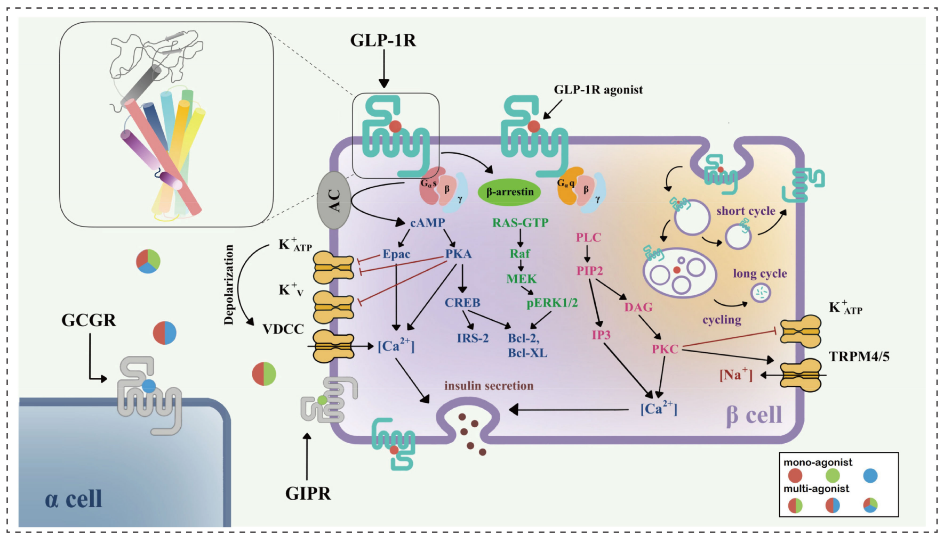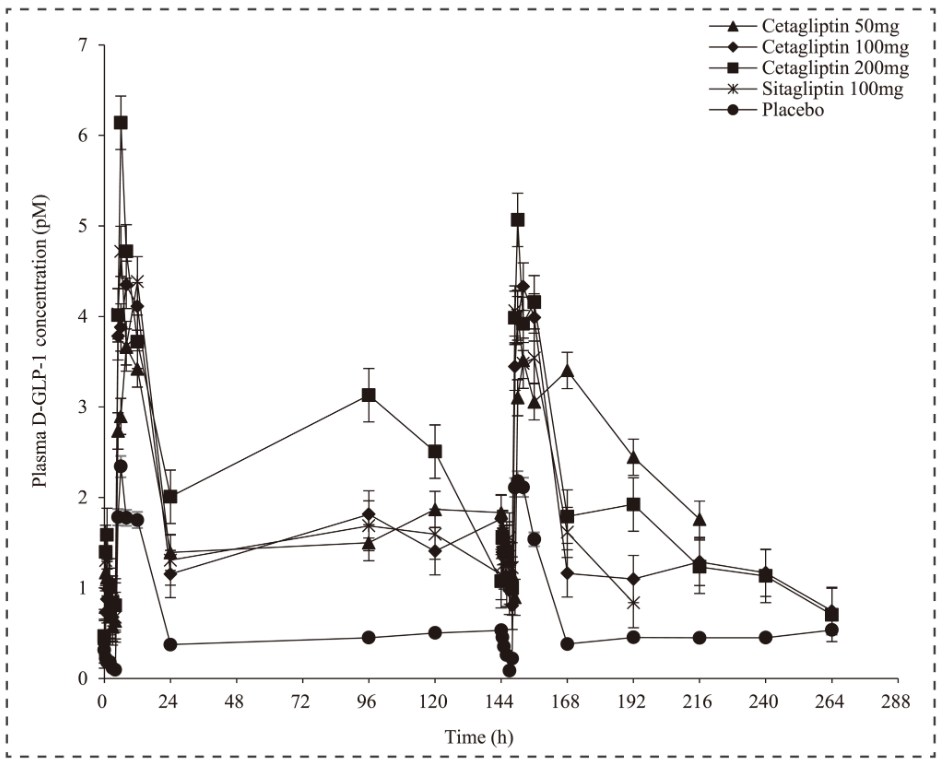Medicilon's GLP-1 New Drug R&D ServiceA Story by MedicilonMedicilon provides GLP-1 drug discovery, CMC research (API + formulation), pharmacodynamics research, PK study, GLP-1 safety evaluation and other services. As of the end of May 2023, Medicilon has suc Type 2 diabetes is a progressive disease. The disease course is primarily characterized by a decline in �™-cell function and worsening of insulin resistance. Therefore, various antidiabetic agents are under research and development. The hypoglycemic strategy has also shifted from "sugar control" to both "sugar control" and "heart protection". GLP-1R agonists can improve left ventricular ejection fraction, myocardial contractility, coronary blood flow, cardiac output, and endothelial function while reducing infarction size and overall risks for a cardiovascular event. Other functions of GLP-1 include increased glucose uptake in the muscles, decreased glucose production in the liver, neuroprotection, and increased satiety due to direct actions on the hypothalamus. At present, the therapeutic application and potential value of GLP-1RAs in diabetes has become a research hotspot. In the formulation of GLP-1 integrated research plan, Medicilon has in-depth communication with customers. The backbone of scientific research has combined the characteristics of each case with years of practical experience and technical accumulation, and carefully submitted high-quality experimental plans and results to customers. Medicilon provides GLP-1 drug discovery, CMC research (API + formulation), pharmacodynamics research, PK study, GLP-1 safety evaluation and other services. As of the end of May 2023, Medicilon has successfully assisted in the clinical approval of 7 GLP-1 drugs (3 approved by FDA and NMPA,1 approved by FDA, NMPA, and TGA) and has multiple GLP-1 projects under development. www.medicilon.com/platform/drug-discovery GLP-1 Glucagon like peptide-1 (GLP-1) is the second incretin identified in 1983. GLP-1 is a polypeptide that is mainly produced by intestinal L cells and is encoded by the proglucagon gene. GLP-1 exists in the human body in two active forms, GLP-1 (7-36 amide) and GLP-1 (7-37), with the proportion of GLP-1 (7-36 amide) being higher. GLP-1 mainly targets pancreatic islet cells and exerts its effects through specific receptors. GLP-1 also increases pancreatic �™-cell proliferation by stimulating genes involved in cell proliferation and decreases the apoptosis of these cells by inhibiting caspase-3 expression. Furthermore, GLP-1 delays gastric emptying, suppresses glucagon secretion, and decreases gastrointestinal motility and nutrient ingestion. GLP-1 shows numerous actions in different tissues and a broad therapeutic potential. Therefore, GLP-1 plays a very active role both in the treatment and pathogenesis of diabetes.  Multiple physiological effects of GLP-1[1] Medications for diabetes comprise either GLP-1 receptor agonists, with short (one or two daily injections: Exenatide, Liraglutide, Lixisenatide) or long duration (one injection once weekly: extended-released Exenatide, Albiglutide, Dulaglutide, Taspoglutide); or oral compounds inhibiting dipeptidyl peptidase-4 (DPP-4), the enzyme that inactives GLP-1, also called gliptins (Sitagliptin, Vildagliptin, Saxagliptin, Linagliptin, Alogliptin). Although both pharmacological approaches target GLP-1, important differences exist concerning the mode of administration (subcutaneous injection versus oral ingestion), the efficacy (better with GLP-1 agonists), the effects on body weight and systolic blood pressure (diminution with agonists versus neutrality with gliptins), the tolerance profile (nausea and possibly vomiting with agonists) and the cost (higher with GLP-1 receptor agonists). Both agents may exert favourable cardiovascular effects. Gliptins may represent a valuable alternative to a sulfonylurea or a glitazone after failure of monotherapy with metformin while GLP-1 receptor agonists may be considered as a good alternative to insulin (especially in obese patients) after failure of a dual oral therapy. Intravenously administered GLP-1 has a biological half-time of approximately only 1�"2 min. GLP-1 is degraded rapidly by the ubiquitous enzyme dipeptidyl-peptidase IV (DPP-4).  Differences between GLP-1 receptor agonists and DPP-4 inhibitors[1] Glucagon-like peptide-1 receptor (GLP-1R) is a critical therapeutic target for type 2 diabetes mellitus (T2DM). Numerous drugs targeting GLP-1R have entered clinical treatment. GLP-1R, together with four other glucagon receptors (GCGR, GLP-2R, GIPR, and GHRHR), belongs to the secretin (class B1) GPCR family, whose endogenous ligands are peptide hormones. After activation by full agonists such as GLP-1, GLP-1R couples with Gαs, activates adenylate cyclase (AC), and causes the accumulation of cAMP. With increasing cAMP levels, protein kinase A (PKA) and the exchange protein directly activated by cAMP-2 (Epac-2) are also activated. PKA and Epac-2 trigger the closure of KATP and KV channels, which depolarizes the cell membrane, opens voltage-dependent calcium channels (VDCC), and causes Ca2+ influx.  Signaling pathways of GLP-1R in pancreatic �™-cell[2] CMC Research of GLP-1 In most cases, peptide therapeutics are administered by injection. Molecular modification of peptide drug can be performed to improve their stability, extend their in vivo half-life and make them long-acting. Strategies such as amino acid substitution or cyclization, PEGylation, fusion of long-acting fragments (fusion with Fc, fusion with human serum albumin), and conjugation of fatty acid chains are commonly used, and several drugs have been successfully marketed. PEG modification increased the stability of protein and peptide drugs, increased the solubility, reduced the immunogenicity, prolonged the residence time in blood, reduced the protease degradation, and reduced the frequency of drug use. Innovations in pharmaceutical formulations have substantially improved therapeutic peptide administration by providing the following advantages: long-acting delivery, precise dose administration, retention of biological activity, and improvement of patient compliance. Microparticles, microspheres, and microcapsules are widely used constituents of multiparticulate drug delivery systems, offering both therapeutic and technological advantages. The peptide has been studied for injectable or implantable sustained release depot systems for the targeted or localized delivery of drugs. Exenatide, a 39-amino acid peptide, is the first GLP-1R agonists approved by the US FDA in 2005 and EMA in 2007. Exenatide, a peptide drug widely used for the treatment of type 2 diabetes mellitus, is greatly limited due to its short plasma half-life of 2.4 hours. To prolong the half-life of Exenatide, a water in oil in oil (W/O/O) method was employed to prepare exenatide-loaded PLGA microspheres. Exenatide loaded PLGA microspheres can be used for long-acting antidiabetic therapy. The Exenatide extended-release formulation depot, has been approved in the USA for once weekly treatment for type 2 diabetes mellitus. Medicilon can provide API process development and preparation R&D services for GLP-1 drugs. Medicilon has established a platform for the development of cGMP APIs and has developed GMP APIs for clinical trials for innovative drug companies. Medicilon team continues to assist the development of GLP-1 drugs through rigorous design of experiments (DOE), professional R&D technology, standardized project management, efficient communication, etc. Pharmacology Evaluation of GLP-1 Medcilon provides mature models for for evaluating the efficacy of GLP-1 in vivo. Our animal models are all established and maintained under the regulation of AAALAC. Pharmacology studies are conducted according to GLP-like standards. At present, more than 300 tumor evaluation models in six categories have been established by Medicilon. Various laboratory animal ❖Rodents: Mouse/Rat, Rabbit ❖Non-Rodents: Beagle Dog, Mini Pig, Non-human Primate Medicilon Case: Active GLP-1 assayThis study was conducted in a small, selected population of healthy subjects with normoglycaemia. The results suggest that Cetagliptin, at doses ≥50 mg once daily (QD), exhibited minimal accumulation, inhibited plasma DPP-4 activity by >80% over a 24-hour dosing interval, and increased active glucagon-like-1 peptide (GLP-1) levels without producing hypoglycaemia. The active GLP-1 assays were performed by Medicilon Preclinical Research LLC. Generally, Cetagliptin has favourable clinical tolerability and safety.  Active GLP-1 Assay[3] Pharmacokinetic (PK) Studies of GLP-1 Medcilon provides high quality quantification assays for key parameters in GLP-1 PK study, presenting accurate results. Medicilon Case: Pharmacokinetic (PK) studies  Pharmacokinetic properties of Compound A Compound A and Reference compound were evaluated for its pharmacokinetic (PK) properties in cynomolgus monkeys. Cynomolgus monkeys were administered subcutaneously with 0.02, 0.05, and 0.1 mg/kg of Compound A. The experimental results showed that the average Cmax ratio was 1:2.8:6.5, and the average AUC(0-t ) ratios are 1:2.8:5.7, Cmax and AUC(0-t) increase approximately in proportion to the dose increase. After a single subcutaneous administration of 0.02 mg/kg Compound A and 0.02 mg/kg Reference compound, the relative bioavailability was 82.9%. Medicilon Assist Projects ❖Semaglutide Injection (ZT001 Injection) On September 30, 2022, Beijing Peptide Biomedical Technology Co., Ltd. (Bejing Peptide) Semaglutide (ZT001) injection was officially accepted by CDE. Semaglutide is an antidiabetic medication used for the treatment of type 2 diabetes and an anti-obesity medication used for long-term weight management. As a partner of Bejing Peptide, Medicilon provides a full set of preclinical research services for Bejing Peptide semaglutide Injection. ❖ZT002 On August 29, 2022, Beijing Peptide Biomedical Technology Co., Ltd. (Bejing Peptide) ZT002 injection was approved by the Australian Human Research Ethics Committee for Phase I clinical trials. On October 5, Bejing Peptide's ZT002 completed the administration of the first participants in Phase I clinical trials in Australia. Under the guidance of the innovation strategy, the R&D pipeline of Bejing Peptide has been advanced efficiently and the results have been continuous, which reflects the outstanding ability of Bejing Peptide in the field of innovative research and development in the field of metabolic diseases. As a partner of Bejing Peptide, Medicilon provides pharmacodynamics services to ZT002 that comply with the application in China, US and Australia. ❖MDR-001 On December 26, 2022, MindRank announced US FDA clearance of IND application for MDR-001. MDR-001 is a novel, orally bioavailable small-molecule GLP-1R agonist discovered using MindRank's proprietary AI platform, Molecule Pro™. In the comprehensive preclinical studies, MDR-001 has demonstrated excellent functional potency and selectivity, with favorable ADME properties and oral bioavailability, as well as desirable pharmacokinetics and tolerability. MDR-001's superior preclinical efficacy and safety profiles indicate its best-in-class potential for obesity and type 2 diabetes mellitus indications with large unmet medical needs. As a partner of MindRank, Medicilon provides API process development and preparation R&D services for MDR-001. Summary Glucagon-like peptide-1 receptor agonists (GLP-1 RAs) have emerged as a new antidiabetic drug class with multiple metabolic effects. GLP-1 RAs have pleiotropic actions, with intervention on multiple regulation mechanisms. Their safety and efficacy were demonstrated in multiple trials. Due to significant beneficial cardiovascular effects and improved glycemic control, GLP-1 RAs are now recommended in type 2 diabetes patients with increased glycosylated hemoglobin A1c (HbA1c) level, alongside with first-line therapy and even with insulin treatment. This indicates an increased interest in the cardiovascular effects of GLP-1 RAs therapy. As one of the few biopharmaceutical preclinical research companies with comprehensive service capabilities in the CRO industry in China, Medicilon has been catching up with innovation, insight and the latest technological development for near 20 years, building a technical service platform for the development direction of global innovative drugs, and helping to accelerate the registration and declaration of new drugs. The Medicilon clinical registration affairs service platform has a professional IND and ANDA research team, which has an in-depth understanding of the registration regulations and policies of China, the United States, Australia, the European Union and other countries and regions, as well as the technical requirements for chemical drugs. Medicilon can provide clients in China with NMPA IND declaration and US FDA IND/ANDA declaration services, and can provide NMPA IND/ANDA declaration services for foreign clients. Medicilon can customize a practical registration strategy, avoid potential registration risks, ensure timely and accurate submission of application materials, and track the review progress to help clients quickly complete the registration review process. References: [1] Baptist Gallwitz. The evolving place of incretin-based therapies in type 2 diabetes. Pediatr Nephrol. 2010 Jul;25(7):1207-17. doi: 10.1007/s00467-009-1435-z. [2] Wenwei Wan, et al. GLP-1R Signaling and Functional Molecules in Incretin Therapy. Molecules. 2023 Jan 11;28(2):751. doi: 10.3390/molecules28020751. [3] Jinmiao Lu, et al. A double-blind, randomized, placebo and positive-controlled study in healthy volunteers to evaluate pharmacokinetic and pharmacodynamic properties of multiple oral doses of Cetagliptin. Br J Clin Pharmacol. 2022 Jun;88(6):2946-2958. doi: 10.1111/bcp.15209. [4] André J Scheen. GLP-1 receptor agonists or DPP-4 inhibitors: how to guide the clinician? Ann Endocrinol (Paris). 2013 Dec;74(5-6):515-22. doi: 10.1016/j.ando.2012.06.002. [5] Xin Zhao, et al. GLP-1 Receptor Agonists: Beyond Their Pancreatic Effects. Front Endocrinol (Lausanne). 2021 Aug 23;12:721135. doi: 10.3389/fendo.2021.721135. [6] Serap Koral Taşçı, et al. GLP-1 Localisation and Proglucagon Gene Expression in Healthy and Diabetic Mouse Ileum. J Vet Res. 2018 Oct 24;62(2):237-242. doi: 10.2478/jvetres-2018-0033. Contact Us- E-mail: Address: ❖ 585 Chuanda Rd, Pudong, Shanghai, China, 201299 (Headquarters) ❖ 1 Broadway, 9th Fl, Cambridge Innovation Center, Cambridge, MA 02142, US ❖ Kelvinstraat 41b, 6601 HH Wijchen, The Netherlands ❖ Allia Future Business Centre Kings Hedges Road Cambridge CB4 2HY, UK
© 2023 Medicilon |
StatsAuthorMedicilonCambridge, MAAboutMedicilon is an integrated contract research organization (CRO), providing comprehensive one-stop new drug R&D services for pharmaceutical enterprises and scientific research institutions around the w.. more..Writing
|

 Flag Writing
Flag Writing